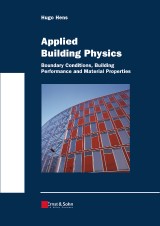Details
Applied Building Physics
Boundary Conditions, Building Performance and Material Properties1. Aufl.
|
52,99 € |
|
| Publisher: | Ernst & Sohn |
| Format | EPUB |
| Published: | 09.01.2012 |
| ISBN/EAN: | 9783433601273 |
| Language: | englisch |
| Number of pages: | 322 |
DRM-protected eBook; you will need Adobe Digital Editions and an Adobe ID to read it.
Descriptions
Note: New editions of this book have been published: 2nd edition in 2016; 3rd edition in September 2023.<br> The energy crises of the 1970s, persisting moisture problems, complaints about sick buildings, thermal, visual and olfactory discomfort, and the move towards more sustainability in building construction have pushed Building Physics to the forefront of building innovation. The societal pressure to diminish energy consumption in buildings without impairing usability acted as a trigger to activate the whole notion of performance based design and construction. As with all engineering sciences, Building Physics is oriented towards application, which is why, after a first book on fundamentals this second volume examines performance rationale and performance requirements. Outdoor and indoor climate conditions are described and calculation values are discussed, the performance concept is specified at the building level and at the building envelope level, and heat-air-moisture material properties are defined.<br> The book incorporates 35 years of teaching Building Physics to architectural, building and civil engineers, bolstered by 40 years of experience, research and consultancy.<br>
PREFACE<br> INTRODUCTION<br> OUTDOOR AND INDOOR CONDITIONS<br> Overview<br> Outdoor Conditions<br> Dry bulb (or air) temperature<br> Solar radiation<br> Long wave radiation<br> Relative humidity and (partial water) vapour pressure<br> Wind<br> Precipitation and wind-driven rain<br> Standardized outside climate values<br> Indoor conditions<br> Dry bulb (or air) temperature<br> Relative humidity and (partial water) vapour pressure<br> Water vapour release indoors<br> Indoor climate classes<br> Indoor/outdoor air pressure differentials<br> PERFORMANCE METRICS AND ARRAYS<br> Definitions<br> Functional demands<br> Performance requirements<br> Some history<br> Performance arrays<br> FUNCTIONAL REQUIREMENTS AND PERFORMANCES AT THE BUILDING LEVEL<br> Thermal comfort<br> Health and indoor environmental quality<br> Energy efficiency<br> Durability<br> Life cycle costs<br> Sustainability<br> HEAT-AIR-MOISTURE PERFORMANCES AT THE ENVELOPE LEVEL<br> Introduction<br> Air-tightness<br> Thermal transmittance (U)<br> Transient thermal response<br> Moisture tolerance<br> Thermal bridges<br> Contact coefficients<br> Hygrothermal stress and strain<br> Example of performance control: timber-framed walls<br> HEAT-AIR-MOISTURE MATERIAL PROPERTIES<br> Introduction<br> Dry air and water<br> Building and insulation materials<br> APPENDIX
Prof. Em. Dr. IR. Hugo S.L.C Hens, Katholieke Universiteit Leuven (Belgium), taught Building Physics from 1975 to 2003, Performance Based Building Design from 1970 to 2005 and Building Services from 1975 to 1977 and 1990 to 2008. He has authored and co-authored over 150 articles and conference papers, and written hundreds of reports on building damage cases and their solution. He has been coordinating the international working group CIB W40 on Heat and Mass Transfer in Buildings for ten years. Between 1986 and 2008, he was operating agent of 4 Annexes, initiated by the International Energy Agency's EXCO on Energy Conservation in Buildings and Community Systems: Annex 14, Annex 24, Annex 32 and Annex 41. He is a fellow of the American Society of Heating, Refrigeration and Air Conditioning Engineers (ASHRAE).
The energy crisis of the 1970s, persisting moisture problems, complaints about sick buildings, thermal, visual and olfactory discomfort, and the move towards more sustainability in building construction have pushed Building Physics to the forefront of building innovation. The societal pressure to diminish energy consumption in buildings without impairing usability acted as a trigger to activate the whole notion of performance based design and construction. As with all engineering sciences, Building Physics is oriented towards application, which is why, after a first book on fundamentals this second volume examines performance rationale and performance requirements. Outdoor and indoor climate conditions are described and calculation values are discussed, the performance concept is specified at the building level and at the building envelope level, and heat-air-moisture material properties are defined. Tho book incorporates 35 years of teaching Building Physics to architectural, building and civil engineeers, bolstered by 40 years of experience, research and consultancy.


















